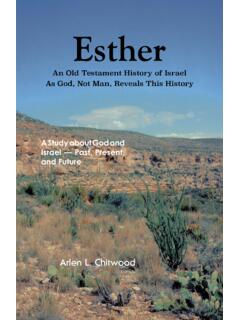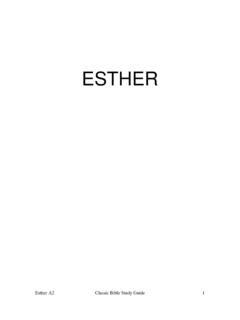Transcription of Esther and History - Andrews University
1 Esther and History William H. Shea In this study of Esther for the Anchor Bible series, C. A. Moore divided the arguments against the historicity of the book into three The first category, carrying the least weight, consists of those aspects of the book which Moore considers improbable though not spe-cifically contradicted by external Moore's evaluation of the balance of the arguments against the historicity of Esther is, Even more serious are certain statements in Esther which seem to contradict extrabiblical sources whose basic accuracy in the matter is not suspect. Some of these discrepancies or "contradic-tions" are quite minor, such as the one hundred and twenty-seven provinces in the empire mentioned in i 1, in contrast to Hero-dotus, who said there were twenty satrapies; Esther 's arrival at the court of Susa in 480 (ii 16), a time when, according to Herodotus, Xerxes would still have been away fighting in Greece; and Mordecai as part of Nebuchadnezzar's deportation of 597 (ii 6), which would make him, and especially Esther , far too old to have accomplished everything attributed to them.
2 Other contradictions are of a much more serious nature: according to ii 16 and iii 7, Esther was queen between the seventh and twelfth years of Xerxes' reign, but according to Herodotus, Amestris was queen then; moreover, again according to Herodotus (iii 84), Persian queens had to come from one of seven noble Persian families, a custom which would have automatically ruled out an insignificant In evaluating these criticisms, the distinctively chronological ones have been selected for more detailed examination here, , the date when Esther came to court, and the dates the Bible gives for the occasions when she was queen. Given the identification of Esther 's Ahasuerus as Xerxes,4 it is obvious that the dates for Esther 's activities must relate in some way or another to the dates of Xerxes' Greek campaign, and the Dr.
3 William H. Shea is a researcher at the Biblical Research Institute of the General Conference of Seventh-day Adventists at their Church World Head-quarters in Washington, This article is reprinted by permission of Andrews University Seminary Studies, in which publication it was first printed (Vol. 15, 1976). 234 two sets of data must be considered together. Moore's other criticisms will be touched upon briefly in conclusion, but our emphasis here is specifically upon the chronological ones because Persian, Babylonian, Egyptian, and Greek sources offer a fairly detailed chronological outline of Xerxes' reign with which the dates from Esther can be Aside from the Greek historians, however, inscriptional materials of a political or historical nature from Xerxes' reign are scant; consequently the limitations those sources place upon the historian should be noted.
4 Unfortunately, the vast store of resources available from the Perse-polis Fortification tablets antedate the reign of Xerxes; therefore they offer no help with the History of his Of the eighty-five Persepolis Treasury tablets published by Cameron, sixty-six come from the times of Xerxes, but they are of a selective administrative nature and offer only indirect information about the major events of his Xerxes' royal inscriptions shed little light upon the concrete History of his The Incantation texts in Aramaic from Persepolis include nineteen texts from Xerxes' reign, but they provide even less historical information than the Treasury tablets In spite of the extensive excavations by the French at Susa, the scene of the action in Esther .
5 Only one admin-istrative text from the Achaemenid period has been found there, and it was mistranslated until Hallock corrected that translation in Per-haps the renewed excavations there will find the Achaemenid-period tablets that have eluded the excavators thus far. Babylonian contract tablets from the reign of Xerxes are also scarce; consequently less in-formation is obtainable from them than from the larger collections dated to his Persian predecessors. Finally, the classical historians almost uni-versally lost interest in Xerxes after his forces were defeated at Plataea and Mykale in 479; thus they provide little information bearing upon the events described in Esther that are dated later in his reign.
6 One factor that compensates to some extent for this state of our information regarding Xerxes' reign is the number of excellent full-length studies of the Persian-Greek wars that have been published re-cendy. No less than three such works have appeared in the last decade: Xerxes9 Invasion of Greece by Charles Hignett,11 Xerxes at Sahmis by Peter Green,12 and Persia and the Greeks by A. R. In addition, G. B. Grundy's classic, The Great Persian War, was reissued in These studies of the classical sources provide detailed descriptions of the move-ments of Xerxes and his armies from 481 to 479 with which the chron-ological notations in Esther can be correlated. In view of the availability of this information it should not be difficult to correlate the dates in Esther with those of this period.
7 The first event of significance in Xerxes' reign with which we are acquainted is his suppression of the Egyptian revolt. Darius died late in CONCORDIA JOURNAL/JULY 1987 235 486, before he was able to attend to that revolt, thus leaving it for Xerxes to deal Since inscriptions in Egypt dated to Xerxes began to appear early in 484, his suppression of that revolt can be dated to 485, and Herodotus has noted the severity with which he subjugated the With Egypt under control again, Xerxes was free to direct his attention to the campaign against Greece. With good reason, then, it has been suggested that the 180-day "banquet" in Xerxes' third year referred to in Esther 1:1-3 was connected with laying plans for that Greek campaign.
8 The presence of the "army" (MT) or the "officers of the army" (LXX) in Susa at that time (v. 3) lends some support to the suggestion. Herodotus, incidentally, devotes a dozen lengthy paragraphs to Xerxes' discussion with his nobles and generals describing the decision to carry out the campaign against Greece (7. 8-19). Because of the intense heat at Susa in the summer time, it is possible that this lengthy conference took place in the winter, or from the fall to the spring according to the chronology of Esther . The Fortification tab-lets from Persepolis illustrate this aspect of the royal use of Susa, since "only 6 texts record travel to Susa in the 5 months 111-VII (roughly, June through October), while 42 texts record travel to Susa in the other 7 months (VIII-II).
9 "17 Since it seems reasonable to conclude that these six months from Esther would have ended in the spring, the seven-day celebration that followed it (v. 5) could also fit well with the New Year's festival. This would be in accord with the statement that the entire pop-ulace of Susa was involved in that celebration. If this was indeed a New Year's festival, it should have marked the beginning of Xerxes' fourth regnal year. And if the preceding conference was called to plan the Greek campaign, then that same fourth year might have been the one intended for carrying out that plan. The delay until his fifth year for the start of the campaign can be attributed not only to the time necessary to organize his army and its supplies according to Herodotus (7.)
10 20), but also to the revolt that occurred in Babylonia. The proposed campaign and the Babylonian revolt might even be related as cause and effect, if the occasion for the revolt was a refusal by the Babylonians to contribute forces to Xerxes' The Babylonian revolt against Xerxes has been difficult to date be-cause of conflicting information in the classical sources about it. Ctesias reported that Xerxes suppressed this revolt before he went on his Greek campaign, while Arrian located that event after his return from There is no information in Herodotus that supports one view over the other. Because of the difference of opinion between Ctesias and Arrian on this subject, Cameron's study of Xerxes' titulary in the contract tablets from Babylonia appears to be the best basis upon which to date this king's subjugation of Babylon: 236 The really marked change, and one which may well indicate royal exasperation with the refractory people of Babylonia, comes with the fifth year.



















